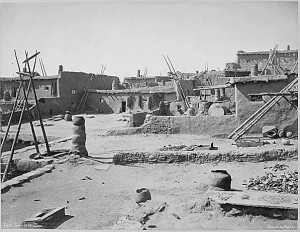
Zuni turquoise is one of the most sought after gemstones on the planet, and rightly so. Its beauty and unique characteristics make it one of the most treasured forms of turquoise in existence. Zuni turquoise is sourced and crafted into jewelry by the Zuni Indians.
The Zuni people have been creating jewelry with turquoise for years. Research suggests that the Zuni have resided in their current location for nearly 4,000 years. Below is a short history and description of Zuni turquoise, which is frequently found in Zuni turquoise jewelry.
Zuni Turquoise Formation
Zuni turquoise is created in much the same way that all other forms of turquoise are. The technical name for turquoise is hydrus copper aluminum phosphate. It is created when feldspar and apatite are combined with hot copper-dense lava that seeps up through the surface of the Earth. The lava releases phosphoric acid into the apatite, which then melts the aluminum in the feldspar and separates it from the rest of the material.
Then, the copper becomes infused with oxygen close to the surface of the Earth and combines with the phosphoric acid and aluminum in small crevices in the Earth. These crevices are usually not larger than an inch wide. Water and time are the final ingredients to this process, which eventually creates Zuni turquoise. Zuni turquoise is found close to the surface of the Earth, as is the case with all turquoise.
Zuni Turquoise Properties and Characteristics
The Zuni people, who live in western New Mexico, likely discovered the turquoise in their area by finding it on the ground. Turquoise likes to stay close to the surface of the Earth, and can often be seen just by looking on the ground. The Zuni people likely discovered it in this manner, and then began to dig and mine for it. Zuni turquoise may be formed just like any other form of turquoise, but its characteristics are quite unique. Zuni turquoise is often very monochromatic, which is unusual for this gemstone.
Other forms of turquoise, such as Navajo turquoise, is often mosaic or crackled in appearance. However, Zuni turquoise is usually very smooth and consistent in color. Also, while some forms of Zuni turquoise have the trademark green tone of turquoise, it usually has a very bright teal tone, almost resembling dyed howlite. In fact, some rare forms of Zuni turquoise are a bright sapphire blue, completely uncharacteristic of most turquoise.
Zuni turquoise is a beautiful gemstone and a very rare form of turquoise. Its unique consistency, smoothness, and color make it stand out among the turquoise family. This beautiful gem is often combined with silver in Native American jewelry, although the use of metal in Native American jewelry is a rather modern creation. Regardless of the type of jewelry being designed, Zuni turquoise is a great option to include to create a unique and beautiful piece.
